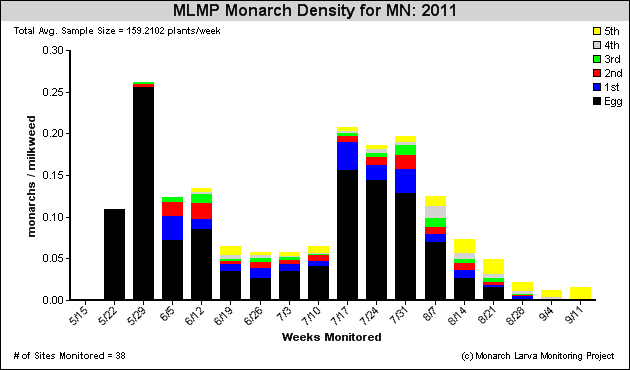| Please Report Your Sightings! |
This Week's Update Includes:
- News: Migration Nearly Complete
- Get Involved: Monarch Larva Monitoring Project
- The Migration: Maps and Journal
 |
| Have you noticed? |
It's only the last day of May, but the monarchs have nearly completed their migration. After three months and two generations, the butterflies have almost recolonized their breeding range. Measuring from the starting point in Mexico, monarchs are now 2,000 miles north and 3,000 miles northeast of the overwintering region.
Report Your First!
No matter when you see your first monarch, we want to know about it. Your sighting is important even if other people have already reported from your region.
The Cycle Continues
"I saw my first monarch today. She was flying around my garden for several hours and laying lots of eggs," wrote Cyndie Glutting from Hull, Massachusetts. Monarchs live only 2-6 weeks during the breeding season. The tiny scratches on this butterfly's wings show signs of age. This monarch is probably a first-generation butterfly, a child of the monarchs from Mexico. The eggs she lays in Massachusetts will be the grandchildren of the monarchs from Mexico. The cycle will continue all summer. By next fall, the monarchs that migrate may be the great-great-grandchildren of those that left Mexico this spring!
Also Appearing
In many regions, the Eastern Tiger Swallowtail appears at the same time that monarchs arrive. This large, yellow butterfly does not migrate. Where does it come from? And why is it called a tiger swallowtail? More...
 |
| Photo: Cyndie Glutting |
| The Cycle Continues |
|
| Did You Know? A monarch only lives for 2-6 weeks during the summer breeding season. |
 |
| Photo: Elizabeth Howard |
| Also Appearing |
Monarchs have been unusually early and abundant this spring. Does this mean we'll have an unusually large monarch population this summer and fall?
Volunteers Needed
You can help scientists find out by monitoring monarch density in your butterfly garden. The Monarch Larva Monitoring Project (MLMP) is a citizen science project for volunteers in the United States and Canada. The focus of the project is on monarch distribution and abundance during the breeding season. The goal is to better understand how and why monarch populations vary in time and space. Visit the Monarch Larva Monitoring Project (MLMP) to:
- Set up your own monitoring site. Count monarchs and milkweed at your site once per week.
- Look at monarch density data. You can find data that have been collected in your own state or province during the past 15 years. Find out how 2012 compares so far.
Try This!
This sample MLMP monarch density graph shows data collected last summer by volunteers in Minnesota. How did monarch density change over the summer months of 2011? This graph shows what the data reveal.
Monarch Density
Sample MLMP Graph
 |
 |
 Journal |
| First Monarch (map | animation | sightings) |
First Milkweed (map | animation | sightings) |



